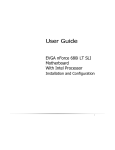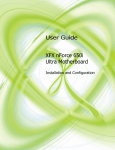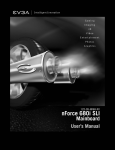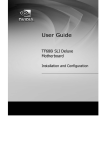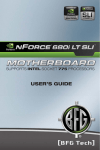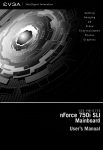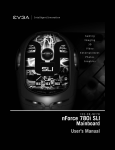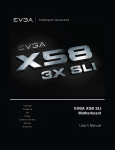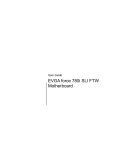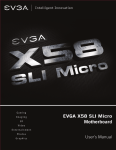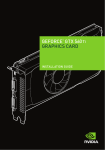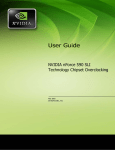Download EVGA 650I Computer Hardware User Manual
Transcript
User Guide EVGA nForce 650i Ultra Motherboard for Intel Processor Installation and Configuration March 2007 EVGA V1.0 Installing and Configuring the NVIDIA nForce 650i Ultra Motherboard Table of Contents Before You Begin… .................................................................................... viii Parts NOT in the Kit.......................................................................................viii Intentions of the Kit........................................................................................ ix Introduction ..................................................................................................1 Features .........................................................................................................1 Ultimate Overclocking ..................................................................................1 High-speed Memory .....................................................................................1 Comprehensive Overclocking Tools................................................................1 NVIDIA nTune Utility ................................................................................1 NV BIOS..................................................................................................2 True x16 PCI Express Support.......................................................................2 DualDDR2 Memory Architecture ....................................................................2 NVIDIA MediaShield™ Storage ......................................................................2 Multiple Disk Setup ......................................................................................2 DiskAlert System..........................................................................................2 RAID Morphing ............................................................................................3 Bootable Multidisk Array ...............................................................................3 Networking with NVIDIA nForce....................................................................3 NVIDIA Native Gigabit Ethernet.....................................................................3 NVIDIA FirstPacket™ Technology ..................................................................3 High Definition Audio (HDA) .........................................................................3 USB 2.0 ......................................................................................................4 Motherboard Specifications ..............................................................................5 ii Unpacking and Parts Descriptions ...............................................................7 Unpacking ......................................................................................................7 Equipment ......................................................................................................7 NVIDIA nForce 650i Ultra Motherboard .............................................................8 Hardware Installation .................................................................................11 Safety Instructions ........................................................................................ 11 Preparing the Motherboard............................................................................. 12 Installing the CPU ...................................................................................... 12 Installing the CPU Fan................................................................................ 13 Installing Memory DIMMs ........................................................................... 13 Installing the Motherboard ............................................................................. 14 Installing the I/O Shield ............................................................................. 14 Securing the Motherboard into the Chassis................................................... 14 Connecting Cables and Setting Switches.......................................................... 15 Power Connections .................................................................................... 16 24-pin ATX Power (PWR1) ...................................................................... 16 8-pin ATX 12V Power (PWR2).................................................................. 17 Connecting IDE Hard Disk Drives ................................................................ 17 Connecting Serial ATA Cables ..................................................................... 18 Connecting Internal Headers....................................................................... 19 Front Panel Header ................................................................................ 19 USB Headers ......................................................................................... 21 Audio........................................................................................................ 22 Fan Connections ........................................................................................ 23 COM1 ....................................................................................................... 23 FDD Connector .......................................................................................... 23 Expansion Slots ......................................................................................... 24 iii Installing and Configuring the NVIDIA nForce 650i Ultra Motherboard PCI Slots ............................................................................................... 24 PCI Express x1 Slots............................................................................... 25 PCI Express x16 Slot .............................................................................. 25 Jumper Settings ............................................................................................ 25 Clear CMOS Jumper: CLR_CMOS ................................................................. 25 Configuring the BIOS ..................................................................................26 Enter BIOS Setup .......................................................................................... 27 Main Menu.................................................................................................... 27 Standard CMOS Features Menu ...................................................................... 30 Date and Time........................................................................................... 31 IDE Channel and SATA Channel .................................................................. 31 Drive A ..................................................................................................... 33 Halt On ..................................................................................................... 33 Memory .................................................................................................... 34 Advanced BIOS Features................................................................................ 35 Removable Device Priority .......................................................................... 36 Hard Disk Boot Priority ............................................................................... 36 Network Boot Priority ................................................................................. 36 CPU Internal Cache.................................................................................... 36 Quick Power On Self Test ........................................................................... 37 First/Second/Third Boot Device ................................................................... 37 Boot Other Device...................................................................................... 37 Boot Up NumLock Status ............................................................................ 37 Security Option.......................................................................................... 38 APIC Mode ................................................................................................ 38 MPS Version Control For OS........................................................................ 38 Full Screen LOGO Show.............................................................................. 38 Advanced Chipset Features ............................................................................ 39 iv System Clocks ........................................................................................... 40 Frequency Settings................................................................................. 41 HT Multiplier .......................................................................................... 42 Spread Spectrum ................................................................................... 42 FSB & Memory Config ................................................................................ 43 CPU Configuration...................................................................................... 47 System Voltages ........................................................................................ 48 NVMEM Memory Test ................................................................................. 50 Load Timing/Voltage Set ............................................................................ 50 Save Timing/Voltage Set ............................................................................ 51 System BIOS Cacheable ............................................................................. 51 HPET Function........................................................................................... 51 NVIDIA GPU Ex ......................................................................................... 51 Integrated Peripherals Menu .......................................................................... 52 IDE Function Setup .................................................................................... 53 RAID Config .............................................................................................. 54 USB Config................................................................................................ 54 MAC Config ............................................................................................... 55 HD Audio .................................................................................................. 55 IDE HDD Block Mode ................................................................................. 55 Onboard FDC Controller ............................................................................. 55 Onboard Serial Port 1................................................................................. 55 Power Management Setup Menu..................................................................... 56 ACPI Function............................................................................................ 56 ACPI Suspend Type ................................................................................... 56 Soft-Off by PBNT ....................................................................................... 57 WOL(PME#) From Soft-Off ......................................................................... 57 v Installing and Configuring the NVIDIA nForce 650i Ultra Motherboard Power On by Alarm .................................................................................... 57 POWER ON Function .................................................................................. 57 PnP/PCI Configuration Menu........................................................................... 58 Init Display First ........................................................................................ 59 Reset Configuration Data............................................................................ 59 Resources Controlled By ............................................................................. 59 IRQ Resources........................................................................................... 60 PCI/VGA Palette Snoop............................................................................... 60 Maximum Payload Size ............................................................................... 60 System Monitor Menu .................................................................................... 61 Dynamic Fan Control.................................................................................. 62 vi vii Before You Begin… Parts NOT in the Kit This kit contains all the hardware necessary to install and connect your new EVGA nForce® 650i Ultra motherboard. However, it does not contain the following items that must be purchased separately to make the motherboard functional. Intel microprocessor: Intel Core 2 Extreme, Intel Core 2 Quad, Intel Core 2 Dual, Pentium Cooling fan for the microprocessor System memory support: Supports dual channel DDR2 533/667/800. Supports up to 8 GBs DDR2 memory. Power Supply To calculate the power you are going to require for your specific configuration, go to www.slizone.com. These instructions tell you how to install each of the parts listed so you can have a functioning motherboard. As you go through the installation instructions, we are assuming you have purchased the necessary parts. viii Introduction Intentions of the Kit This kit provides you with the motherboard and all connecting cables necessary to install the motherboard into a PC cabinet. If you are building a PC, you will use most of the cables provided in the kit. If however, you are replacing a motherboard, you will not need many of the cables. When replacing a motherboard in a PC cabinet, you will need to reinstall an operating system even though the current drives have an operating system. ix Introduction Thank you for buying the EVGA nForce® 650i Ultra Motherboard. This motherboard offers the tools and performance PC users’ demand. Features Ultimate Overclocking Unleash the underlying hardware. With comprehensive overclocking tools to push the limits on front side bus (FSB) speed and support for higher memory speeds, the NVIDIA nForce 650i Ultra MCPs were designed for overclocking. High-speed Memory This board supports high-speed memory up to DDR2-800 to keep pace with overclocked system components. Comprehensive Overclocking Tools Award-winning NVIDIA overclocking tools provide a complete kit of tools giving everyone from the most veteran enthusiast to the novice overclocker the ability to unleash the hardware in their PC. NVIDIA nTune Utility NVIDIA nTune™ is a Windows-based utility that has added access to more settings. Adjust CPU and memory speeds without rebooting. You can also access most BIOS settings from inside Windows without having to go into the BIOS. Save and automatically load profiles for each application you run. 1 Installing and Configuring the NVIDIA nForce 650i Ultra Motherboard NV BIOS NV BIOS delivers easy-to-use tuning to let you have full control over your hardware including processor voltage tables and memory drive strengths. True x16 PCI Express Support One full-bandwidth, 16-lane PCI Express link ensure maximum graphics performance for next-generation GPUs and games. DualDDR2 Memory Architecture A state-of-the-art Dual DDR2 memory controller allows high bandwidth and low latency data access to the CPU and GPU. Ensures data and information are relayed through the system as quickly as possible for incredible performance. NVIDIA MediaShield™ Storage NVIDIA MediaShield is a suite of features that safeguards your most important digital media assets; always reliable, scalable, and accessible. MediaShield includes RAID and SATA drive support. Multiple Disk Setup Through a simple wizard-based interface, you can effortlessly set up your drives for better data protection, faster disk access or maximum storage capacity. MediaShield automatically selects RAID 0, 1, 0+1 or 5 configurations according to your needs. Advanced users can access RAID options directly. DiskAlert System In the event of a disk failure, MediaShield users see an image that highlights which disk has failed to make it easier to identify, replace, and recover. 2 Introduction RAID Morphing MediaShield allows users to change their current RAID set-up to another configuration in a one-step process called morphing. This eliminates the need to back up data and follow multiple steps in the process. Bootable Multidisk Array MediaShield storage fully supports the use of multi-disk array for loading the operating system at power-up. Networking with NVIDIA nForce NVIDIA networking delivers the highest network throughput at the lowest CPU utilization. The manageable and stable NVIDIA networking solution results in better networking management and a lower total cost of ownership. Only NVIDIA integrates this level of networking features to allow you to take your online experience to the next level. NVIDIA Native Gigabit Ethernet The industry’s fastest Gigabit Ethernet performance eliminates network bottlenecks and improves overall system efficiency and performance. NVIDIA FirstPacket™ Technology Be the ‘King of Ping’ with NVIDIA FirstPacket technology. Get the crystalclear phone conversations and online gaming performance you expect. NVIDIA FirstPacket technology assures your game data, VoIP conversations, and large file transfers are delivered according to preferences set by you in an intuitive wizard. High Definition Audio (HDA) High definition audio brings consumer electronics quality sound to the PC delivering high quality sound from multiple channels. Using HDA, systems can deliver 192 kHz/32-bit quality for eight channels, supporting new audio formats. 3 Installing and Configuring the NVIDIA nForce 650i Ultra Motherboard USB 2.0 USB 2.0 is standard plug-and-play interface that provides easy-to-use connectivity for USB devices. 4 Introduction Motherboard Specifications Size ATX form factor of 12 inch x 9.6 inch Microprocessor support Intel Core 2 Extreme, Intel Core 2 Quad, Intel Core 2 Dual, Pentium Operating systems: Supports Windows XP 32bit/64bit and Windows Vista 32bit/64bit Contains NVIDIA nForce 650i Ultra MCP and SPP System Memory support Supports dual channel JEDEC DDR2-533/667/800. Supports up to 8 GBs DDR2 memories. USB 2.0 Ports ¾ Supports hot plug ¾ Eight USB 2.0 ports (four rear panel ports, four onboard USB headers) ¾ Supports wake-up from S1 and S3 mode ¾ Supports USB 2.0 protocol up to 480 Mbps transmission rate ¾ 300MBps data transfer rate ¾ Four Serial ATA II connectors ¾ NVIDIA MediaShield RAID with support for RAID 0, RAID 1, RAID 0+1, RAID 5, and JBOD ¾ Supports hot plug and NCQ (Native Command Queuing ) Onboard LAN ¾ Single LAN interface built-in onboard ¾ Supports 10/100/1000 Mbit/sec Ethernet Audio ¾ Azalia High-Definition audio ¾ Supports 8-channel audio ¾ Supports S/PDIF output ¾ Supports Jack-Sensing function 5 Installing and Configuring the NVIDIA nForce 650i Ultra Motherboard PCI Express x16 Support ¾ Supports 4 GB/sec (8 GB/sec concurrent) bandwidth ¾ Low power consumption and power management features Green Function ¾ Supports ACPI (Advanced Configuration and Power Interface) ¾ Supports S0 (normal), S1 (power on suspend), S3 (suspend to RAM), S4 (Suspend to disk - depends on OS), and S5 (soft - off) Expansion Slots ¾ Three PCI slots ¾ Two PCI Express x1 slot ¾ One PCI Express x16 Graphics slot 6 Unpacking and Parts Descriptions Unpacking The NVIDIA nForce 650i Ultra motherboard comes with all the necessary cables for adding a motherboard to a new chassis. If you are replacing a motherboard, you may not need many of these cables. Be sure to inspect each piece of equipment shipped in the packing box. If anything is missing or damaged, contact your reseller. All parts shipped in this kit are RoHS-compliant (lead-free) parts. Equipment The following equipment is included in the NVIDIA nForce 650i Ultra motherboard box. NVIDIA nForce 650i Ultra Motherboard This PCI Express motherboard contains the NVIDIA nForce 650i Ultra SPP and MCP. I/O Shield Installs in the chassis to block radio frequency transmissions, protect internet components from dust and foreign objects and aids in proper airflow within the chassis. Floppy Cable Used to attach a floppy drive to the motherboard. 7 Installing and Configuring the NVIDIA nForce 650i Ultra Motherboard 2-Port SATA Power Cable USB 2.0 4-Port Cable Provides four additional USB ports to the back panel of the chassis. SATA Signal Cable (Qty Four) Used to support the Serial ATA protocol and each one connects a single drive to the motherboard Comm2 Bracket Cable IDE-ATA 133 HDD Cable NVIDIA nForce 650i Ultra Motherboard The NVIDIA nForce 650i Ultra motherboard with the NVIDIA nForce 650i Ultra SPP and MCP processors is a PCI Express motherboard. Figure 1 shows the motherboard and Figures 2 shows the back panel connectors. 8 Unpacking and Parts Description 16 15 19 15 15 18 17 17 20 14 1 2 13 3 12 11 4 10 9 8 7 6 1. 2. 3. 4. 5. 6. 7. CPU Socket NVIDIA SPP with (passive) CPU fan connector DDR DIMM slots 0 - 3 24-pin ATX power connector IDE connector NVIDIA MCP (passive) Figure 1. 5 8. Serial-ATA connectors 9. Front panel connector 10. Floppy drive connector 11. System fan connector 12. Motherboard battery 13. USB headers 14. Serial connector 15. PCI slots 16. Front Panel Audio connector 17. PCI Express x1 slots 18. PCI Express x16 slot (GPU) 19. Backpanel connectors (Figure 2) 20. 8-pin ATX_12V power connector NVIDIA nForce 650i Ultra Motherboard Layout 9 Installing and Configuring the NVIDIA nForce 650i Ultra Motherboard 1 4 2 1. 2. 3. 4. 5 3 PS/2 Mouse Port PS/2 Keyboard Port USB 2.0 ports (two) Lan Port with LEDs to indicate status. • Yellow/Light Up/Blink = 10 Mbps/Link/Activity • Yellow and Green/Light Up/Blink = 100 Mbps/link/Activity • Green/Light Up/Blink = 1000 Mbps/Link/Activity 5. USB 2.0 6. Port Blue Green Pink Orange Black Grey Figure 2. 10 Ports (two) 2-Channel Line-In Line-Out Mic In 4-Channel Line-In Front Speaker Out Mic In Rear Speaker Out 6-Channel/8-Channel Line-In Front Speaker Out Mic In Center/Subwoofer Rear Speaker Out Chassis Backpanel Connectors 6 Hardware Installation This section will guide you through the installation of the motherboard. The topics covered in this section are: Preparing the motherboard ¾ Installing the CPU ¾ Installing the CPU fan ¾ Installing the memory Installing the motherboard Connecting cables and setting switches Safety Instructions To reduce the risk of fire, electric shock, and injury, always follow basic safety precautions. Remember to remove power from your computer by disconnecting the AC main source before removing or installing any equipment from/to the computer chassis. 11 Installing and Configuring the NVIDIA nForce 650i Ultra Motherboard Preparing the Motherboard The motherboard shipped in the box does not contain a CPU or memory. You need to purchase a CPU, a CPU fan assembly, and memory to complete this installation. Installing the CPU Be very careful when handling the CPU. Make sure not to bend or break any pins on the back. Hold the processor only by the edges and do not touch the bottom of the processor. Use the following procedure to install the CPU onto the motherboard. 1. Unhook the socket lever by pushing down and away from the socket. 2. Lift the load plate. There is a protective socket cover on the load plate to protect the socket when there is no CPU installed. 3. Remove the protective socket cover from the load plate. 4. Remove the processor from its protective cover, making sure you hold it only by the edges. It is a good idea to save the cover so that whenever you remove the CPU, you have a safe place to store it. 5. Align the notches in the processor with the notches on the socket. 6. Lower the processor straight down into the socket with out tilting or sliding it into the socket Note: Make sure the CPU is fully seated and level in the socket. 7. Close the load plate over the CPU and press down while you close and engage the socket lever. 12 Align notches with notches on the CPU Hardware Installation Installing the CPU Fan There are many different fan types that can be used with this motherboard. Follow the instruction that came with you fan assembly. Be sure that the fan orientation is correct for your chassis type and your fan assembly. Installing Memory DIMMs Your new motherboard has four 1.8V 240-pin slots for DDR2 memory. These slots support 256 Mb, 512 Mb, 1 Gb, and 2GB DDR2 modules. They also support dual channel DDR2 memory technology up to 10.7GB/s. There must be at least one memory bank populated to ensure normal operation. Use the following the recommendations for installing memory. (See Figure 1 on page 9 for the location of the memory slots on the card) One DIMM: Install into slot 0. You can install the DIMM into any slot, however, slot 0 is preferred. Two DIMMs: Install into either slots 0 and 1 or 2 and 3. The idea is to not have the DIMMs in adjacent slots. Four DIMMS: Install into slots 0, 1, 2, and 3. CPU side DIMM Slot 0 DIMM Slot 2 DIMM Slot 1 DIMM Slot 3 Card-edge side Use the following procedure to install memory DIMMs into the slots on the motherboard. Note that there is only one gap near the center of the DIMM slot. This slot matches the slot on the memory DIMM to ensure the component is installed properly. 1. Unlock a DIMM slot by pressing the module clips outward. 2. Align the memory module to the DIMM slot, and insert the module vertically into the DIMM slot. The plastic clips at both sides of the DIMM slot automatically lock the DIMM into the connector. 13 Installing and Configuring the NVIDIA nForce 650i Ultra Motherboard Installing the Motherboard The sequence of installing the motherboard into the chassis depends on the chassis you are using and if you are replacing an existing motherboard or working with an empty chassis. Determine if it would be easier to make all the connections prior to this step or to secure the motherboard and then make all the connections. Use the following procedure to install the I/O shield and secure the motherboard into the chassis. Note: Be sure that the CPU fan assembly has enough clearance for the chassis covers to lock into place and for the expansion cards. Also make sure the CPU Fan assembly is aligned with the vents on the covers. Installing the I/O Shield The motherboard kit comes with an I/O shield that is used to block radio frequency transmissions, protects internal components from dust and foreign objects, and promotes correct airflow within the chassis. Before installing the motherboard, install the I/O shield from the inside of the chassis. Press the I/O shield into place and make sure it fits securely. If the I/O shield does not fit into the chassis, you would need to obtain the proper size from the chassis supplier. Securing the Motherboard into the Chassis Most computer chassis have a base with mounting studs or spacers to allow the mother board to be secured to the chassis and help to prevent short circuits. If there are studs that do not align with a mounting hole on the motherboard, it is recommended that you remove that stud to prevent the possibility of a short circuit. 1. Carefully place the motherboard onto the studs/spacers located inside the chassis. 2. Align the mounting holes with the studs/spacers. 3. Align the connectors to the I/O shield. 4. Ensure that the fan assembly is aligned with the chassis vents according to the fan assembly instruction. 5. Secure the motherboard with a minimum of eight-to-ten screws. 14 Hardware Installation Connecting Cables and Setting Switches This section takes you through all the connections and switch settings necessary on the motherboard. This will include: Power Connections ¾ 24-pin ATX power (PWR1) ¾ 8-pin ATX 12V power (PWR2) Internal Headers ¾ Front panel ¾ USB Headers ¾ Audio ¾ COM FDD IDE Serial ATA II Chassis Fans Rear panel USB 2.0 Adapter Expansion slots CMOS jumper settings See Figure 1 on page 9 to locate the connectors and jumpers referenced in the following procedure. 15 Installing and Configuring the NVIDIA nForce 650i Ultra Motherboard Power Connections This motherboard requires an ATX power supply. Make sure you have enough power to cover all the expansion cards you will be installing. To determine what you power requirements are for your specific configuration, refer to www.slizone.com. 24-pin ATX Power (PWR1) is the main power supply connector located along the edge of the board next to the DIMM slots. Make sure that the power supply cable and pins are properly aligned with the connector on the motherboard. Firmly plug the power supply cable into the connector and make sure it is secure. PWR1 PWR1 connector Plug power cable from system power supply to PWR1 Card edge Figure 3. PWR1 Motherboard Connector Table 1. PWR1 Pin Assignments Connector 24 12 16 13 1 Pin Signal Pin Signal 1 +3.3V 13 +3.3V 2 +3.3V 14 -12V 3 GND 15 GND 4 +5V 16 PS_ON 5 GND 17 GND 6 +5V 18 GND 7 GND 19 GND 8 PWROK 20 RSVD 9 +5V_AUX 21 +5V 10 +12V 22 +5V 11 +12V 23 +5V 12 +3.3V 24 GND Hardware Installation 8-pin ATX 12V Power (PWR2) PWR2, the 8-pin ATX 12V power connection, is used to provide power to the CPU. Align the pins to the connector and press firmly until seated. Backpanel connector edge. 5 1 12V GND 8 4 Connect a four-pin power plug to pins 3, 4, 7, and 8. 5 1 It is strongly recommended that you use an 8-pin ATX 12V power supply; however, if you have a four-pin power supply, plug the connector to pins 1, 2, 5, and 6 as shown. Connecting IDE Hard Disk Drives The IDE connector supports Ultra ATA 133/100/66 IDE hard disk drives. 1. Connect the blue connector (the cable end with a single connector) to the motherboard. 2. Connect the black connector (the cable with the two closely spaced black and gray connectors) to the Ultra ATA master device. 3. Connect the gray connector to a slave device. If you install two hard disk drives, you must configure the second drive as a slave device by setting its jumper accordingly. Refer to the hard disk documentation for the jumper settings. Note: If an ATA-66/100 disk drive and a disk drive using any other IDE transfer protocol are attached to the same cable, the maximum transfer rate between the drives may be reduced to that of the slowest drive. 17 Installing and Configuring the NVIDIA nForce 650i Ultra Motherboard Connecting Serial ATA Cables The Serial ATA II connector is used to connect the Serial ATA II device to the motherboard. These connectors support the thin Serial ATA II cables for primary storage devices. The current Serial ATA II interface allows up to 300MB/s data transfer rate. There are four serial ATA connectors on the motherboard that support RAID 0, RAID 1, RAID 5, RAID 0+1 and JBOD configurations. SATA 4 SATA 3 SATA 2 SATA 1 GND GND TX+ TX- 1. Connect the locking cable end to the motherboard connector. 2. Connect the end without the lock to the drive. 18 GND RX+ TX- Hardware Installation Connecting Internal Headers Front Panel Header The front panel header on this motherboard is one connector used to connect the following four cables: PWRLED Attach the front panel power LED cable to these two pins of the connector. The Power LED indicates the system’s status. When the system is in S0 status, the LED is on. When the system is in S1, S3, S4, S5 status, the LED is off. No Connect RESET HD_LED + 9 1 10 2 1 Blank PWRSW + PWRLED Note: The power LED cable in some chassis is a three pin connector with the pins installed in positions 1 and 3. If your chassis has a three pin connector, you will need to remove pin 3 and put it into position 2 or you can use a pair of scissors to cut out position 2. Most chassis come with a two pin connector. PWRSW Attach the power button cable from the case to these two pins. Pressing the power button on the front panel turns the system on off rather than using the power supply button. HD_LED Attach the hard disk drive indicator LED cable to these two pins. The HDD indicator LED indicates the activity status of the hard disks. RESET Attach the Reset switch cable from the front panel of the case to these two pins. The system restarts when the RESET switch is pressed. 19 Installing and Configuring the NVIDIA nForce 650i Ultra Motherboard Table 2. 20 Front Panel Header Pins Pin Signal In/Out HD_LED 1 HD_PWR Out Description Hard disk LED pull-up to +5V 3 HDA# Out Hard disk active LED PWRLED 2 HDR_BLNK_GRN Out Front panel green light 4 HDR_BLNK_YEL Out Front panel yellow light RESET 5 GND 7 FP_RESET# In Reset switch PWRSW 6 SWITCH_ON# In Power switch 8 GND No Connect 9 No Connect Empty 10 Empty Ground Ground Hardware Installation USB Headers This motherboard contains four (4) USB 2.0 ports that are exposed on the rear panel of the chassis. The motherboard also contains two 10-pin internal header connectors onboard that can be used to connect an optional external bracket containing four (4) more USB 2.0 ports. 1. Secure the bracket to either the front or rear panel of your chassis (not all chassis are equipped with the front panel option). 2. Connect the two ends of the cables to the USB 2.0 headers on the motherboard. Table 3. USB 2.0 Header Pins Connector Pin USB 2.0 Header Connector 1 5V_DUAL 2 5V_DUAL 3 D- 4 D- 10 5 D+ 6 D+ 7 8 7 GND 8 GND 5 6 9 Empty 10 No Connect 3 4 1 2 9 Signal Pin Signal 21 Installing and Configuring the NVIDIA nForce 650i Ultra Motherboard Audio The audio connector supports HD audio standard and provides two kinds of audio output choices: the Front Audio, the Rear Audio. The front Audio supports re-tasking function. Table 4. Front Audio Connector Connector Front Audio Connector 22 Pin Signal 1 PORT1_L 2 AUD_GND 3 PORT1_R 4 PRECENCE_J 5 PORT2_R 6 SENSE1_RETURN 7 SENSE_SEND 8 Empty 9 PORT2_L 10 SENSE2_RETURN Hardware Installation Fan Connections There are two fan connections, the system fan and the CPU fan. The fan speed can be detected and viewed in the System Monitor section of the CMOS Setup. Both fans are automatically turned off after the system enters S3, S4 and S5 CPU fan connector mode. System fan connector Fan Connector 3 2 1 GND +12V SENSE Note that the CPU fan cable can be CPU Fan Connector either a 3-pin or a 4-pin connector. Connect a 3-pin connector to pins 1, 2, 4 3 2 1 and 3 on the motherboard connector. GND SENSE PWR CONTROL COM1 The motherboard kit provides an additional serial COM header for your machine. Connect one side of a switching cable to the header and then attach the serial COM device to the other side of the cable. FDD Connector The motherboard supports a standard 360K, 720K, 1.2M, 1.44m, and a 2.88M floppy disk drive (FDD). 23 Installing and Configuring the NVIDIA nForce 650i Ultra Motherboard Expansion Slots The EVGA nForce 650i Ultra motherboard contains six expansion slots, one PCI Express 16x slot, two PCI Express 1x slots and three PCI slots. For a full list of PCI Express x16 graphics card supported by this motherboard, go to www.nvidia.com/estore. 1 1 1 2 3 2 1 – PCI slots 2 – x1 PCIe slots 3 – PCIe x16 slot (GPU1) Figure 4. Expansion Slots PCI Slots The three PCI slots support many expansion cards such as a LAN card, USB card, SCSI card and other cards that comply with PCI specifications. When installing a card into the PCI slot, be sure that it is fully seated. Secure the card’s metal bracket to the chassis back panel with the screw used to hold the blank cover. 24 Hardware Installation PCI Express x1 Slots There are two PCI Express x1 slots that are designed to accommodate less bandwidth-intensive cards, such as a modem or LAN card. The x1 slot provides 250 MB/sec bandwidth. PCI Express x16 Slot There is one PCI Express x16 slot that is reserved for a graphics or video card. The bandwidth of the x16 slot is up to 4GB/sec (8GB/sec concurrent). When installing a PCI Express x16 card, be sure the retention clip snaps and locks the card into place. If the card is not seated properly, it could cause a short across the pins. Secure the card’s metal bracket to the chassis back panel with the screw used to hold the blank cover. Jumper Settings The motherboard contains a 3-pin BIOS configuration jumper that enables all board configurations to be done in the BIOS Setup program. The silk screen on the motherboard shows a ∆ next to pin 1. Clear CMOS Jumper: CLR_CMOS The motherboard uses the CMOS RAM to store all the set parameters. The CMOS can be cleared by removing the CMOS jumper. Use the following procedure to clear CMOS: 1. Turn off the AC power supply and connect pins 1 and 2 together using the jumper cap. 2. Return the jumper setting to normal (pins 2 and 3. Together with the jumper cap). 4. Turn the AC power supply back on. 25 Configuring the BIOS This section discusses how to change the system settings through the BIOS Setup menus. Detailed descriptions of the BIOS parameters are also provided. This section includes the following information: Enter BIOS Setup Main Menu Standard CMOS Features Advanced BIOS Features Advanced Chipset Features Integrated Peripherals Power Management Setup PnP/PCI Configurations System Monitor Hardware Installation Enter BIOS Setup The BIOS is the communication bridge between hardware and software. Correctly setting the BIOS parameters is critical to maintain optimal system performance. Use the following procedure to verify/change BIOS settings. 1. Power on the computer, 2. Press the Del key when the following message briefly displays at the bottom of the screen during the Power On Self Test (POST). Press F1 to continue, DEL to enter Setup. Pressing Del takes you to the Phoenix-Award BIOS CMOS Setup Utility. Note: It is strongly recommended that you do not change the default BIOS settings. Changing some settings could damage your computer. Main Menu The main menu allows you to select from the list of setup functions and two exit choices. Use the Page Up and Page Down keys to scroll through the options or press Enter to display the associated submenu. Use the arrow keys to position the selector in the option you choose. To go back to the previous menu, press Esc. Note: Note that on the BIOS screens all data in white is for information only, data in yellow is changeable, data in blue is non-changeable, and data in a red box is highlighted for selection. 27 Phoenix – AwardBIOS CMOS Setup Utility ` Standard CMOS Features ` System Monitor ` Advanced BIOS Features Load Defaults ` Advanced Chipset Features Set Password ` Integrated Peripherals Save & Exit Setup ` Power Management Setup Exit Without Saving ` PnP/PCI Configurations Esc : Quit F10 : Save & Exit Setup : Select Item Time, Date, Hard Disk Type.., NVIDIA LinkBoost™ - Not Detected SLI-Ready memory - Disabled Figure 5. 28 BIOS CMOS Setup Utility Main Menu Standard CMOS Features Use this menu to set up the basic system configuration. Advanced BIOS Features Use this menu to set up the advanced system features and boot sequence. Advanced Chipset Features Use this menu to optimize system performance and configure clocks, voltages, memory timings, and more. Integrated Peripherals Use this menu to set up onboard peripherals such as IDE, RAID, USB, LAN, and MAC control. Power Management Setup Use this menu to configure power management, power on, and sleep features. PnP/PCI Configurations Use this menu to modify the system’s Plug-and-Play and PCI configurations. System Monitor Use this menu to monitor the real-time system status of your PC, including temperature, voltages, and fan speed. Hardware Installation The following items on the CMOS Setup Utility main menu are commands rather than submenus: Load Defaults Load default system settings. Set Password Use this command to set, change, and disable the password used to access the BIOS menu. Save & Exit Setup Use this command to save settings to CMOS and exit setup. Exit Without Saving Use this command to abandon all setting changes and exit setup. The following two items on the CMOS Setup Utility main menu are status indicators: 29 Standard CMOS Features Menu The Standard CMOS Features menu is used to configure the standard CMOS information, such as the date, time, HDD model, and so on. Use the Page Up and Page Down keys to scroll through the options or press Enter to display the sub-menu. Use the arrow keys to position the selector in the option you choose. To go back to the previous menu, press Esc. The information shown in Item Help corresponds to the option highlighted. Phoenix – AwardBIOS CMOS Setup Utility Standard CMOS Features Date (mm:dd:yy) Time (hh:mm:ss) ` ` ` ` ` ` Sat, Jul 01 2006 12 : 48: 23 IDE Channel (.) Master IDE Channel (.) Slave SATA Channel 1 Master SATA Channel 2 Master SATA Channel 3 Master SATA Channel 4 Master [None] [None] [None] [None] [None] [None] Drive A Halt On [1.44, 3.5 in.] [All , But Keyboard] Base Memory Extended Memory Total Memory 640K 1047552K 1048576K :Move Figure 6. Enter:Select +/-/PU/PD:Value F5: Previous Values Item Help Main Level ` Change the day, month, year and century F10:Save ESC:Exit F7:Defaults F1:General Help Standard CMOS Features Menu Note: Note that all data in white is for information only, data in yellow is changeable, data in blue is non-changeable, and data in a red box is highlighted for selection. 30 Hardware Installation Date and Time Using the arrow keys, position the cursor over the month, day, and year. Use the Page Up and Page Down keys to scroll through dates and times. Note that the weekday (Sun through Sat) cannot be changed. This field changes to correspond to the date you enter. Note that the hour value is shown in a 24-hour clock format. Time is represented as hour : minute : second. Date (mm:dd:yy) Time (hh:mm:ss) Sat, Jul 01 2006 14 : 48: 43 IDE Channel and SATA Channel Use these functions to detect and configure the individual IDE and SATA channels. Select a channel and press Enter to display the IDE/SATA sub-menu. ` ` ` ` ` ` IDE Channel (.) Master IDE Channel (.) Slave SATA Channel 1 Master SATA Channel 2 Master SATA Channel 3 Master SATA Channel 4 Master [None] [None] [None] [None] [None] [None] Press ENTER to display SATA Channel sub-menu IDE Auto-Detect [Press Enter] Extended IDE Drive Access Mode [None} Auto Capacity 0 MB Cylinder Head Precomp Landing Zone Sector 0 0 0 0 0 Press ENTER to display IDE Channel sub-menu IDE HDD Auto-Detect [Press Enter] IDE Channel 0 Slave Access Mode [Manual} [CHS] Capacity Cylinder Head Precomp Landing Zone Sector 0 MB [ [ [ [ [ 0] 0] 0] 0] 0] 31 Press Enter to auto-detect IDE and SATA channels in the system. Once the channel is detected, the values for Capacity, Cylinder, Heads, Precomp, Landing Zone, and Sector are automatically filled in. None There is no HDD installed or set. Auto The system can auto-detect the hard disk when booting up. Manual When you set the channel to [Manual] and change Access Mode to [CHS], you can then enter the number of cylinders, heads, Precomp, landing zone, and sector. You can manually enter the values or you can press Enter to display a window that tells you the min and max values. IDE HDD Auto-Detect [Press Enter] IDE Channel 0 Slave Access Mode [Manual} [CHS] Capacity Cylinder Head Precomp Landing Zone Sector 0 MB .....0 [ 0] [ 0] [ 0] [ 0] Press ENTER to display sub-menu or enter number manually Cylinder Min= 0 Max=65535 The BIOS supports the following HDD Access Modes: Key in a DEC number : ¾ CHS For HDD less than 528 MB. ¾ LBA :Move ENTER:Accept For HDD greater than 528 MB and supporting LBA (Logical Block Addressing). ¾ Large For HDD greater than 528 MB but not supporting LBA. ¾ Auto Recommended mode. 32 ESC:Abort Hardware Installation Drive A The Drive A option allows you to select the kind of FDD to install. Options are: Drive A Halt On [1.44, 3.5 in.] [All , But Keyboard] None 360K, 5.25 in. 1.2M, 5.25 in. 720K, 3.5 in. 1.44M, 3.5 in. 2.88M, 3.5 in. Press ENTER to display sub-menu Drive A None 360K, 5.25 in. 1.2M, 5.25 in. 720K, 3.5 in. 1.44M, 3.5 in. 2.88M, 3.5 in. ..... ..... ..... ..... ..... ..... Use the Page Up and Page Down keys to scroll :Move ENTER:Accept through the options or press Enter to display the sub-menu. Use the arrow keys to position the selector in the option you choose. Press Enter to accept the changes and return to the Standard CMOS Features menu. [ [ [ [ [ [ ] ] ] ] ] ] ESC:Abort Halt On determines whether or not the computer stops if an error is detected during power on. Use the Page Up and Page Down keys to scroll through the options or press Enter to display the Halt On sub-menu. Use the arrow keys to position the selector in the option you choose. Press Enter to accept the changes and return to the Standard CMOS Features menu. Halt On Drive A Halt On [1.44, 3.5 in.] [All , But Keyboard] All Errors Whenever the BIOS detects a nonfatal error, the system stops and prompts you. No Errors System boot does not stop for any detected errors. All, But Keyboard System boot does not stop for keyboard errors, but does stop for all other errors. Press ENTER to display sub-menu Halt On All Errors No Errors All , But Keyboard All , But Diskette All , But Disk/Key :Move ..... ..... ..... ..... ..... ENTER:Accept [ [ [ [ [ ] ] ] ] ] ESC:Abort 33 All, But Diskette The system boot does not stop for a diskette error but will stop for all other errors. All, But Disk/Key The system boot does not stop for a keyboard or disk error, but will stop for all other errors. Memory These settings are display-only values that are determined by the BIOS POST (Power-On Self Test). Base Memory 640K Extended Memory 1047552K Base Memory Total Memory 1048576K BIOS POST determines the amount of base (or conventional) memory installed in the system. Extended Memory BIOS determines how much extended memory is present during the POST. Total Memory This value represents the total memory of the system. 34 Hardware Installation Advanced BIOS Features Access the Advanced BIOS Features menu from the CMOS Utility Setup screen. Use the Page Up and Page Down keys to scroll through the options or press Enter to display the sub-menu. Use the arrow keys to position the selector in the option you choose. To go back to the previous menu, press Esc. Note: The options that have associated sub-menus are designated by a `, which precedes the option. Press Enter to display the sub-menus. Phoenix – AwardBIOS CMOS Setup Utility Advanced BIOS Features ` Removable Device Priority ` Hard Disk Boot Priority ` Network Boot Priority CPU Internal Cache Quick Power On Self Test First Boot Device Second Boot Device Third Boot Device Boot Other Device Boot Up NumLock Status Security Option APIC Mode MPS Version Control For OS Full Screen LOGO Show :Move Figure 7. [Press Enter] [Press Enter] [Press Enter] [Enabled] [Enabled] [Removable] [CDROM] [Hard Disk] [Enabled] [On] [Setup] [Enabled] [1.4] [Disabled] Enter:Select +/-/PU/PD:Value F5: Previous Values Item Help Main Level ` Select Removable Boot Device Priority F10:Save ESC:Exit F7:Defaults F1:General Help Advanced BIOS Features Menu Note: Note that all data in white is for information only, data in yellow is changeable, data in blue is non-changeable, and data in a red box is highlighted for selection. 35 Removable Device Priority Use this option to select the priority for removable device startup. Press Enter to see the list of removable devices in your system. Use the arrow keys to go to the various devices. Then use the + or – keys to move the device priority up or down in the list. To go back to the previous menu, press Esc. 1. Floppy Disks Hard Disk Boot Priority Use this option to select the priority for HDD startup. Press Enter to see the list of bootable devices in your system. Use the arrow keys to go to the various devices. Then use the + or – keys to move the device priority up or down in the list. To go back to the previous menu, press Esc. 1. Ch0. : ST3802110A 2. Bootable Add-in Cards Use the + and – keys to move the priority of the device within the list Network Boot Priority Use this option to select the priority for network startup. Select Network Boot Priority and press Enter to view available networks. Use the arrow keys to go to the various devices. Then use the + or – keys to move the device priority up or down in the list. To go back to the previous menu, press Esc. 1. Network 0 : 2. Network 1 : <description of network> <description of network> CPU Internal Cache Use this option to enable or disable the CPU internal cache. Use the Page Up and Page Down keys to scroll through the options or press Enter to display the options in a sub-menu. Use the arrow keys to position the selector in the option you choose. 36 Hardware Installation Quick Power On Self Test Enabling this option allows the system to skip certain test while booting, which reduces the time needed to boot the system. Use the Page Up and Page Down keys to toggle between Enable and Disable. First/Second/Third Boot Device Use this option to set the priority sequence of the devices booted at power on. Use the Page Up and Page Down keys to scroll through the options or press Enter to display the sub-menu. Use the arrow keys to position the selector in the option you choose. First Boot Device Removable Hard Disk CDROM Network Disabled :Move ..... ..... ..... ..... ..... ENTER:Accept [ [ [ [ [ ] ] ] ] ] ESC:Abort Boot Other Device With the option set to Enable, the system boots from some other device if the first/second/third boot devices fail. Boot Up NumLock Status This option allows you to select the power-on state of NumLock. Select On to activate the keyboard NumLock when the system is started. Select Off to disable the NumLock key. 37 Security Option The Security Options allows you to require a password every time the system boots or only when you enter setup. Select Setup to require a password to gain access to the CMOS Setup screen. Select System to require a password to access the CMOS Setup screen and when the system boots. APIC Mode Use this function to enable or disable the Advanced Programmable Interrupt Controller (APIC). If you disable this option, you also disable the MPS Version Control for OS option. MPS Version Control For OS Use this function to select the Multi-Processor Specification (MPS) version that BIOS passes to the operating system. Use the Page Up and Page Down keys to scroll through the options. Full Screen LOGO Show This option allows you to enable or disable the display of the full-screen logo when the system boots. Use the Page Up and Page Down keys to toggle between Enable and Disable 38 Hardware Installation Advanced Chipset Features Select Advanced Chipset Features from the CMOS Setup Utility menu and press Enter to display the functions of the Advanced Chipset Functions menu. Phoenix – AwardBIOS CMOS Setup Utility Advanced Chipset Features ` ` ` ` System Clocks FSB & Memory Config CPU Configuration System Voltages NVMEM memory test [Press Enter] [Press Enter] [Press Enter] [Press Enter] [Disable] Load timing/voltage set Save timing/voltage set System BIOS Cacheable HPET Function [Press Enter] [Press Enter] [Disabled] [Enable] NVIDIA GPY Ex [Enable] Item Help Main Level ` Voltage control :Move Figure 8. Enter:Select +/-/PU/PD:Value F5: Previous Values F10:Save ESC:Exit F7:Defaults F1:General Help Advanced Chipset Features 39 System Clocks Select System Clocks from the Advanced Chipset Features menu and press Enter to display the System Clocks menu. From this menu, you are able to specify frequency settings, HT multipliers, and Spread Spectrum settings. Note that in Figure 9, all of the options are listed. On the actual BIOS screen, you will need to scroll down to see all the options. Phoenix – AwardBIOS CMOS Setup Utility System Clocks Parameters **Frequency Settings** CPU Freq, MHz FSB Reference Clock, MHz CPU Multiplier Settings Current Valce 2933.3 1066.7 [11 X] 2933.3 1066.7 11X Main Level PCIe x16_1, MHz PCIe x16_3, MHz PCIe x16_2, MHz SPP<->MCP Ref Clock, MHz [Auto] [Auto] [Auto] [Auto] 100 100 100 100 CPU frequency multiplier. CPU core clock = FSB Ref Clock/4 * CPU Multiplier **HT Multiplier** nForce SPP --> nForce MCP [5 nForce SPP <-- nForce MCP [5 **Spread Spectrum** CPU Spread Spectrum HT Spread Spectrum PCIe Spread Spectrum(SPP) PCIe Spread Spectrum(MCP) SATA Spread Spectrum :Move Figure 9. Item Help ` x] x] [UP Spread] Disabled [Auto] Disabled Disabled Enter:Select +/-/PU/PD:Value F5: Previous Values d F10:Save ESC:Exit F7:Defaults F1:General Help System Clocks Menu Note: Note that all data in white is for information only, data in yellow is changeable, data in blue is non-changeable, and data in a red box is highlighted for selection. 40 Hardware Installation Frequency Settings CPU Freq, MHz This value is set by the CPU Multiplier (value cannot be changed by the user). FSB Reference Clock. MHz This value is set by the system (value cannot be changed by the user). To change FSB speed, memory speeds and memory timing, go to the FSB & Memory screen. CPU Multiplier This value changes the CPU Frequency value depending on the value you choose. Use the Page Up and Page Down keys to scroll through the options. The options are from 6 X through 60 X. PCIe x16_1, MHz Use the Page Up and Page Down keys to scroll through the frequency options for the PCI Express Bus, Slot 1 (the black slot closest to the CPU). Note that as you go higher in value, PCIe Spread Spectrum(SPP) is disabled and cannot be changed from this status. PCIe x16_3, MHz Use the Page Up and Page Down keys to scroll through the frequency options for the PCI Express Bus, Slot 3 (the blue slot in the middle). PCIe x16_2, MHz Use the Page Up and Page Down keys to scroll through the frequency options for the PCI Express Bus, Slot 3 (the black slot farthest from the CPU). SPP<—>MCP Ref Clock, MHz Use the Page Up and Page Down keys to scroll through the frequency options for the reference clock between the SPP chip and the MCP chip. 41 HT Multiplier nForce SPP — —> nForce MCP Use the Page Up and Page Down keys to scroll through the HT multiplier options and set the link speed from the SPP chip to the MCP chip. Values are [1 x] through [5 x]. nForce MCP <— — nForce SPP Use the Page Up and Page Down keys to scroll through the HT multiplier options and set the link speed from the MCP chip to the SPP chip. Values are [1 x] through [5 x]. Spread Spectrum 42 CPU Spread Spectrum Use the Page Up and Page Down keys to scroll through the Spread Spectrum options for the CPU. Option values are [Disabled], [UP Spread], and [Center Spread]. HT Spread Spectrum Disabled PCIe Spread Spectrum (SPP) Use the Page Up and Page Down keys to scroll through the Spread Spectrum options for the SPP PCIe. Option values are [Disabled], [UP Spread], and [Center Spread]. This option reverts to Disabled and cannot be changed when the value for PCIe x16_1 exceeds 100MHz. PCIe Spread Spectrum(MCP) Disabled SATA Spread Spectrum Disabled Hardware Installation FSB & Memory Config Select FSB & Memory Config from the Advanced Chipset Features menu and press Enter to display the FSB & Memory Config menu. This menu provides the means to FSB speeds, memory speed, and memory timing. Phoenix – AwardBIOS CMOS Setup Utility FSB & Memory Config Parameters SLI-Ready Memory Settings Current Value [Disabled] Disabled CPU Freq, MHz 2933.3 CPU Multiplier 11X FSB – Memory Clock Mode [Auto] x FSB (QDR), MHz Auto Actual FSB (QDR), MHz 1066.7 x MEM (DDR), MHz Auto Actual MEM (DDR), MHz 800.0 ` Memory Timing Setting 2933.3 11X 1066.7 800.6 Item Help Main Level `` “CPUOC MAX” realizes the complete optimized memory settings when SLI-Ready memory is installed Optimized memory settings by allowing X% CPU overclocking [Press Enter] CPU overclocking may require manual overvolting of the CPU to improve system stability :Move Figure 10. Enter:Select +/-/PU/PD:Value F5: Previous Values F10:Save ESC:Exit F7:Defaults F1:General Help FSB & Memory Config Menu 43 FSB and Memory Clock Mode Use the Page Up and Page Down keys to scroll through the FSB and Memory Clock Mode options. The options are: ¾ Auto This is the optimal setting since it sets the FSB and memory speeds automatically. ¾ Linked When Link is selected, FSB (QDR), MHz is changed to editable and the FSB speed can be entered manually. As the FSB speed is changed, CPU Freq, MHz changes proportionally. CPU Freq, MHz 2933.3 CPU Multiplier 11X FSB – Memory Clock Mode [Linked] FSB (QDR), MHz [1067] Actual FSB (QDR), MHz 1066.7 x MEM (DDR), MHz Auto Actual MEM (DDR), MHz 800.0 2933.3 11X 1066.7 800.6 ¾ Unlinked When Unlink is selected, FSB (QDR), MHz and MEM (DDR), MHz are changed to editable and the FSB and memory speeds can be entered manually. As the FSB speed is changed, CPU Freq, MHz changes proportionally. FSB – Memory Clock Mode [Linked] FSB (QDR), MHz [1067] Actual FSB (QDR), MHz 1066.7 MEM (DDR), MHz [1067] Actual MEM (DDR), MHz 800.0 44 1066.7 800.6 FSB (QDR), MHz Use the + or – keys to scroll through new values for the CPU FSB frequency Hardware Installation or type in a new value. Note that the Actual FSB (QDR) reflects the actual frequency that takes effect on a reboot. MEM (DDR), MHz Use the + or – keys to scroll through new values for the memory frequency or type in a new value. Note that the Actual MEM (DDR) reflects the actual frequency that takes effect when the system reboots. Memory Timing Setting Press Enter to display the Memory Timing Setting menu. Use this menu to set optimal timings or to manually enter timings. Phoenix – AwardBIOS CMOS Setup Utility Memory Timing Setting Parameters x x x x x Memory Timing Setting [Optimal] tCL (CAS Latency) Auto(5) tRDC Auto(7) tRP Auto(7) tRAS Auto(23) Command Per Clock (CDM) Auto(2T) 5 5 5 18 1T x x x x x ** Advanced Memory Settings ** tRRD Auto(4) tRC Auto(28) tWR Auto(7) tWTR Auto(10) tREF Auto 3 22 5 9 6.1uS :Move Item Help Settings Current Value Enter:Select +/-/PU/PD:Value F5: Previous Values Main Level `` Select [Expert] to enter timings manually F10:Save ESC:Exit F7:Defaults F1:General Help[ ¾ Optimal Use the Page Up and Page Down keys to select Optimal. Optimal prohibits you from manually setting any timing. All timing is set for optimal performance. 45 ¾ Expert Use the Page Up and Page Down keys to select Expert. When Expert is selected, all timing categories are enabled for manual input. Note that you should set the value to Optimal to use the manufacturers’ recommended values. Parameters Memory Timing Setting tCL (CAS Latency) tRDC tRP tRAS Command Per Clock (CDM) Settings Current Value [Expert] [Auto(5)] [Auto(7)] [Auto(7)] [Auto(23)] [Auto(2T)] ** Advanced Memory Settings ** tRRD [Auto(4)] tRC [Auto(28)] tWR [Auto(7)] tWTR [Auto(10)] tREF [Auto] 5 5 5 18 1T 3 22 5 9 6.1uS ª tCL: CAS# latency (options are 1 through 6). ª tRDC: RAS#-to-CAS# Delay for Read/Write commands to the same bank (options are 1 through 7). ª tRP: Row Precharge time. This is the Precharge-to-Active or Autoª ª ª ª ª ª ª 46 to-Refresh of the same bank (options are 1 through 7). tRAS: This is the minimum RAS# active time (options are 1 through 31). Command Per Clock: This is the command timing setting on a per clock unit basis (options are 1T and 2T). tRRD: RAS#-to-RAS# delay of different banks (options are 1 through 15). tRC: RAS#-to-RAS# or auto refresh time of the same bank (options are 1 through 31). tWR: The Write recovery time (options are 2 through 7). tWTR: This is the minimum write-to-read delay with the same chip selected (options are 1 through 10). tREF: This is the DRAM refresh rate (options are Auto, 7.8uS, and 3.9uS). Hardware Installation CPU Configuration Select CPU Configuration from the Advanced Chipset Features menu and press Enter to display the CPU Configuration menu. Phoenix – AwardBIOS CMOS Setup Utility CPU Configuration Limit CPUID MaxVal x Intel SpeedStep CPU Thermal Control C1E Enhanced Halt State Execute Disable Bit Virtualization Technology [Disabled] Disabled [Disabled] [Enabled] [Enabled] [Enabled] CPU CPU x CPU x CPU Enabled [Enabled] Disabled Disabled Core Core Core Core :Move Figure 11. 0 1 2 3 Enter:Select +/-/PU/PD:Value F5: Previous Values Item Help Main Level `` Set linit CPUID MaxVal to 3, should be “Disabled” for WinXP F10:Save ESC:Exit F7:Defaults F1:General Help CPU Configuration Menu Limit CPUID MaxVal Use this function to enable the set limit of the CPUID MaxVal to 3. Set to Disable for Win XP. CPU Thermal Control Use this function to enable or disable TM1 and TM2 support. The options are: ¾ Disable Disable support for TM1 and TM2. ¾ TM1 Only The CPU is thermally throttled by cutting active processor clock cycles. ¾ TM2 Only Thermal throttling is achieved by reducing the CPU multiplier and CPU core voltage. 47 ¾ TM1 & TM2 Enables support for both TM1 and TM2. C1E Enhanced Halt State Enabled, this function reduces the CPU power consumption when the CPU is idle. Idle occurs when the operating system issues a halt instruction. Execute Disable Bit When this function is disabled, it forces the XD feature flag to always return to zero (0). Virtualization Technology When this function is enabled, it allows a VMM to utilize the additional hardware capabilities provided by Intel Virtualization Technology. CPU Core 1 This function allows you to enable or disable CPU Core. System Voltages Select System Voltages from the Advanced Chipset Features menu and press Enter to display the System Voltages menu. Phoenix – AwardBIOS CMOS Setup Utility System Voltages Parameters CPU Core Memory nForce SPP Settings Current Value [Auto] 1.28 [Auto] 1.85V [Auto] 1.20V Item Help Main Level `` Voltage level for CPU Core (CPU VID) :Move Figure 12. 48 Enter:Select +/-/PU/PD:Value F5: Previous Values F10:Save ESC:Exit F7:Defaults System Voltages Menu F1:General Help Hardware Installation CPU Core Use the Page Up and Page Down keys to scroll through the voltages or select [Auto] to automatically set the voltage level for the CPU Core. Memory This function defines the voltage level for the DRAM. Use the Page Up and Page Down keys to select a voltage or select [Auto] to automatically set the voltage. nForce SPP This function defines the core voltage level for the NVIDIA nForce SPP chip. Use the Page Up and Page Down keys to select a voltage (1.20V, 1.30V, 1.40V, 1.50V) or select [Auto] to automatically set the voltage. CPU FSB This function defines the voltage level for the CPU FSB. Use the Page Up and Page Down keys to select a voltage (1.20V, 1.30V, 1.40V,) or select [Auto] to automatically set the voltage. 49 NVMEM Memory Test This function defines whether you run the NVIDIA memory testing module during POST. The options are Fast, Medium, Slow, and Disable. Load Timing/Voltage Set This function loads the system voltages and timing settings that were defined in the System Voltages menu. You can set up to four profile settings using the Save timing/voltage set function. There are four profile options that can be loaded. The default setting is Auto for all settings. Press Enter to see the options. Load timing/voltage set Press Enter to Select Profile Select Profile Select Profile :Move 50 Exit 1 2 3 ..... ..... ..... ..... ENTER:Accept [ [ [ [ ] ] ] ] ESC:Abort Hardware Installation Save Timing/Voltage Set This function saves the system voltages and timing settings that were defined in the System Voltages menu. There are four profile options that can be loaded. The default setting is Auto for all settings. Press Enter to see the options. Save timing/voltage set Press Enter to Select Profile Select Profile Select Profile :Move Exit 1 2 3 ..... ..... ..... ..... ENTER:Accept [ [ [ [ ] ] ] ] ESC:Abort System BIOS Cacheable This function allows you to enable or disable caching the system BIOS. HPET Function This function allows you to enable or disable the High Precision Even Timer (HPET). When Enabled, HPET is used as the timing hardware for multimedia and other time-sensitive application. When HPET is Disabled, the APIC timer is used. NVIDIA GPU Ex To enable or disable this function you need to have the NVIDIA® ForceWare® graphics driver with NVIDIA EX support. When enabled, the system uses the optimized NVIDIA EX graphics driver. 51 Integrated Peripherals Menu Select Integrated Peripherals from the CMOS Setup Utility menu and press Enter to display the Integrated Peripherals menu. Phoenix – AwardBIOS CMOS Setup Utility Integrated Peripherals ` ` ` ` IDE Function Setup RAID Config USB Config MAC Config IEEE1394 controller HD Audio IDE HDD Block Mode Onboard FDC Controller Onboard Serial Port 1 :Move Figure 13. 52 [Press Enter] [Press Enter] [Press Enter] [Press Enter] [Auto] [Auto] [Enabled] [Enabled] [3FB/IRQ4] Enter:Select +/-/PU/PD:Value F5: Previous Values Item Help Main Level F10:Save ESC:Exit F7:Defaults Integrated Peripherals Menu ` F1:General Help Hardware Installation IDE Function Setup Press Enter to display the IDE Function Setup menu. OnChip IDE Channel0 Primary Master PIO Primary Slave PIO Primary Master UDMA Primary Slave UDMA IDE DMA transfer access Serial-ATA Controller IDE Prefetch Mode [Enabled] [Auto] [Auto] [Auto] [Auto] [Enabled] [All Enabled] [Enabled] OnChip IDE Channel0 OnChip IDE Channel0 [Disabled] Use this function to enable x Primary Master PIO Auto or disable the onchip IDE x Primary Slave PIO Auto Channel0. When disabled, x Primary Master UDMA Auto x Primary Slave UDMA Auto the Primary Master/Slave IDE DMA transfer access [Enabled] functions are changed to Serial-ATA Controller [All Enabled] Auto and cannot be IDE Prefetch Mode [Enabled] changed. Primary Master/Slave PIO When OnChip IDE Channel0 is set to [Enabled], you can select a mode for the primary Master and Slave PIO. Select from Auto, or Mode 1 through Mode 4. Primary Master/Slave UDMA When OnChip IDE Channel0 is set to [Enabled], you can disable the primary Master and Slave UDMA or set it to [Auto]. IDE DMA transfer access Use this function to enable or disable IDE DMA transfer access. Serial-ATA Controller This function allows you to enable specific SATA controllers, enable all controllers, or disable all controllers. The options available are [SATA-0], [SATA-0+1], [Enable All], and [Disabled]. IDE Prefetch Mode Use this function to enable or disable the IDE Prefetch mode. 53 RAID Config Press Enter to display the RAID Config menu. RAID SATA SATA SATA SATA SATA SATA Enable 0 Primary 0 Secondary 1 Primary 1 Secondary 2 Primary 2 Secondary RAID RAID RAID RAID RAID RAID [Enabled] [Disabled] [Disabled] [Disabled] [Disabled] [Disabled] [Disabled] RAID Enable RAID Enable [Disabled] x SATA 0 Primary RAID Disabled Use this function to enable or x SATA 0 Secondary RAID Disabled disable RAID. When RAID is x SATA 1 Primary RAID Disabled set to [Disabled], all SATA x SATA 1 Secondary RAID Disabled functions are changed to x SATA 2 Primary RAID Disabled x SATA 2 Secondary RAID Disabled Disabled and cannot be changed. SATA x Primary/Secondary When RAID Enable is set to [Enabled], you can enable or disable the various SATA functions. USB Config Press Enter to display the USB Config menu. OnChip USB USB Keyboard Support USB Mouse Support [Enabled] [Disabled] [Disabled] OnChip USB OnChip USB [Disabled] x USB Keyboard Support Enabled Use this function to enable x USB Mouse Support Enabled specific versions of the USB or disable the onchip USB. When the onchip USB is set to [Disabled], the keyboard and mouse support functions are set to Enabled and cannot be changed. Versions that can be selected are [V1.1+V2.0] or [V1.1]. USB Keyboard/Mouse Support Use these function to enable or disable the onchip WSB support of the keyboard and/or mouse. 54 Hardware Installation MAC Config Press Enter to display the MAC Config menu. MAC0 LAN MAC1 LAN [Enabled] [Disabled] MACx LAN Use these functions to set the MAC0 and/or MAC1 LANs to Auto or disable their functions. HD Audio This function on the Integrated Peripherals menu allows you to enable or disable the integrated High Definition audio. IDE HDD Block Mode Using this function on the Integrated Peripherals menu allows your IDE hard drive needs to support block mode. Select [Enabled] to automatically detect the optimal number of block read/writes per sector the drive can support. Select [Disabled] if your drive does not support block mode. Onboard FDC Controller This function on the Integrated Peripherals menu allows you to enable or disable the onboard FDC controller function. Onboard Serial Port 1 This function on the Integrated Peripherals menu allows you to select the onboard serial port 1 function. Options are [3F8/IRQ4], [2E8/IRQ3], [3E8/IRQ4], [Auto], and [Disabled]. 55 Power Management Setup Menu Select Power Management Setup from the CMOS Setup Utility menu and press Enter to display the Power Management Setup menu. Phoenix – AwardBIOS CMOS Setup Utility Power Management Setup x x x x ACPI function APCI Suspend Type Soft-Off by PBTN WOL(PME#) From Soft-Off [Enabled] [S1&S3] [Instant-Off] [Disabled] Power-on by Alarm Day of Month Alarm Time (hh:mm:ss) Alarm [Disabled] 0 0 : 0 : 0 POWER ON Function KB Power ON Password Hot Key Power On [BUTTON ONLY] Enter Ctrl-F1 :Move Enter:Select +/-/PU/PD:Value F5: Previous Values Figure 14. Item Help Main Level F10:Save ESC:Exit F7:Defaults ` F1:General Help Power Management Setup Menu ACPI Function This function on the Power Management Setup menu allows you to enable or disable the ACPI function. ACPI Suspend Type This function on the Power Management Setup menu allows you to select an ACPI Suspend Type. Types to select from are [S1&S3], [S1(POS)], and [S3(STR)]. 56 Hardware Installation Soft-Off by PBNT This function on the Power Management Setup menu allows you to set SoftOff by PBNT to [Instant-Off] or [Delay 4 Sec]. WOL(PME#) From Soft-Off This function on the Power Management Setup menu allows you to enable or disable WOL(PMW#) from soft-off. Power On by Alarm This function on the Power Management Setup menu allows you to enable or disable the Power-on by alarm function. Set to [Disable] to prevent poweron by alarm. When set to [Enable], you can manually put in the day of the month and the time of the alarm. Power-on by Alarm Day of Month Alarm Time (hh:mm:ss) Alarm [Disabled] [ 0] [0 : 0 : 0] To enter a day or time, use the Page Up and Page Down keys to scroll through numbers or enter the number using the keyboard number or the + and – keys. POWER ON Function This function on the Power Management Setup menu allows you to define the power-on function. Options for this function are: BUTTON ONLY Keyboard 98 Password When [Password] is selected, the KB Power ON Password function is enabled so that you must enter a password. x POWER ON Function KB Power ON Password Hot Key Power On [Password] [Enter] Ctrl-F1 57 Hot Key Power On When [Hot Key] is selected, the Hot key Power On function is enabled so that you must select a keyboard key as the hot key. To select a hot key use Ctrl+F1 though Ctrl+F12. x POWER ON Function KB Power ON Password Hot Key Power On [Hot key] Enter [Ctrl-F1] Mouse Left Mouse Right Any Key PnP/PCI Configuration Menu Select PnP/PCI Configuration from the CMOS Setup Utility menu and press Enter to display the PnP/PCI Configuration menu. Phoenix – AwardBIOS CMOS Setup Utility PnP/PCI Configuration x Init Display First Reset Configuration Data [PCI Slot] [Disabled] Resources Controlled By IRQ Resources [Auto(ESCD)] Press Enter Item Help Main Level ` ** PCI Express relative items ** Maximum Payload Size [4096] :Move Figure 15. 58 Enter:Select +/-/PU/PD:Value F5: Previous Values F10:Save ESC:Exit F7:Defaults PnP/PCI Configuration Menu F1:General Help Hardware Installation Init Display First This function on the PnP/PCI Configuration menu allows you to define if the initial display is in the PCI slot or in the PCI Express slot. Options are [PCI Slot] and [PCIEx]. Reset Configuration Data This function on the PnP/PCI Configuration menu allows you to enable or disable the resetting of Extended System Configuration Data (ESCD) when you exit Setup. Set this to [Enabled] if you have installed a new add-on and the system reconfiguration has caused a serious conflict that prevents the OS from booting. The default setting is [Disabled]. Resources Controlled By This function on the PnP/PCI Configuration menu allows you to define if the BIOS can automatically configure all the boot and plug-and-play compatible devices or if you can manually select IRQ, DMA, and memory base address fields. Select [Auto(ESCD)] if you want the BIOS to automatically populate these fields. If you select [Manual] so you can assign the resources, IRQ Resources is enabled for input. Resources Controlled By [Auto(ESCD)] x IRQ Resources Press Enter Resources Controlled By [Manual)] IRQ Resources [Press Enter] 59 IRQ Resources To enable this field for input, set Resources Controlled By to [Manual]. With this field enabled, press Enter to see options. IRQ-5 IRQ-9 IRQ-10 IRQ-11 IRQ-14 IRQ-15 assigned assigned assigned assigned assigned assigned to to to to to to [PCI Device] [Reserved] [PCI Device] [PCI Device] [PCI Device] [PCI Device] Use Legacy ISA for devices compliant with the original PC AT Bus specification. Use PCI/ISA PnP for devices compliant with the plug-and-play standard, whether designed for PCI or ISA Bus architecture. PCI/VGA Palette Snoop This function on the PnP/PCI Configuration menu allows you to enable or disable the Palette Snoop function. Maximum Payload Size This function on the PnP/PCI Configuration menu allows you to set the maximum TLP payload size (in bytes) for the PCI Express devices. Use the Page Up and Page Down keys to scroll through sizes or enter the number using the keyboard numbers or use the + and – keys to go up and down the list of sizes. 60 Hardware Installation System Monitor Menu Select System Monitor from the CMOS Setup Utility menu and press Enter to display the System Monitor menu. Phoenix – AwardBIOS CMOS Setup Utility System Monitor ` Dynamic Fan Control CPU CPU Core CPU FSB Memory +3.3V +3.3V Dual +12V +5V +Vbat 1.28V 1.19V 1.81V 3.16V 3/16V 11.92V 4.99V 3.00V CPU Fan Speed Aux Fan Speed nForce Fan Speed Chassis Fan Speed Chassis Fan2 Speed :Move Figure 16. [Press Enter] 47ºC/ 117ºF 4272 4891 0 0 0 Item Help Main Level ` RPM RPM RPM RPM RPM Enter:Select +/-/PU/PD:Value F5: Previous Values F10:Save ESC:Exit F7:Defaults F1:General Help System Monitor Menu All of the values shown in Blue are dynamic and change as the speed and voltages of the various components change with system usage. 61 Dynamic Fan Control Press Enter to display the Dynamic Fan Control menu. x CPU Fan Speed Control [SmartFan] If temp > 70ºC, Set Fan Speed 100% If temp < 30ºC, Set Fan Speed 0% Manual Fan Speed, % 100 AUX Fan Speed Control, % [100] nForce Fan Speed Control, % [100] Chassis Fan Speed Control, % [100] Use this menu to control the speed of the various fans on the motherboard. Set CPU fan speed to [SmartFan] when you want the speed of the fans automatically controlled based on temperature. To set the fan speed to a constant rate, select [Manual] and then enter the speed from 0% to 100%. Set the desired speed for the Aux, nForce, and Chassis fans from 0% to 100%. The system defaults to 100%. 62 Hardware Installation 63











































































